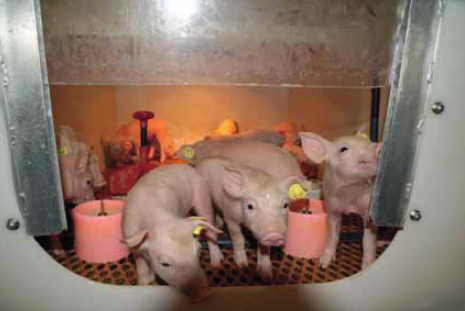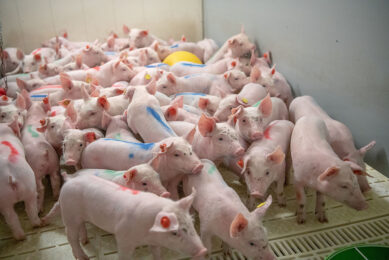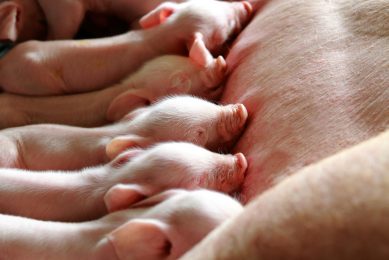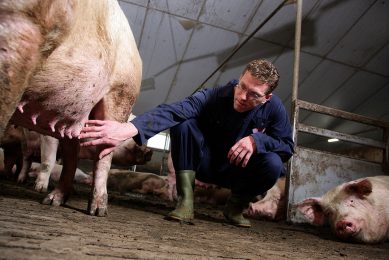A rescue package for piglets in need

Gone are the days where a milk replacer was reached for as an emergency. Now, with litter sizes on the increase, milk replacers and their feeding systems are becoming part of everyday management on progressive sow units. However, do they give good results and do they call for more labour?
Automatic milk supplementation for piglets was introduced in the 1990s. One of the drivers was research by Zijlstra and others (1996) where trials compared rearing piglets on milk replacer from day 18 to the performance of those reared on the sow. They found that piglets fed on milk replacer grew 20% faster than those reared on the sow as shown in Figure 1.
These early results indicated that the sow’s milk production was insufficient to meet the whole piglet growth potential. At this time, and for use in these trials, milk was supplied by ‘artificial sows’ like ‘Porcimat’ or ‘Emma’. Weak and/or surplus piglets were put in a crate that was equipped with an artificial sow. This device was supplied with prepared milk which was delivered to the piglets in a kind of trough. For management reasons, including space and labour input, this concept did not really break through on a large scale.
And also, at this time, with average litter sizes of around 11 even in the more progressive pig producing countries, demand for such a system was limited.
However, the situation has changed and the use of milk replacers for piglets has increased dramatically in the past five years. The main reason is to support management in herds where litter size has increased. Figure 2shows the increase in litter sizes in Denmark in the past decade and which now stands at 14 piglets. Other countries in Europe have followed a similar trend.
An increase in litter size has led to more weak and surplus piglets. To help these piglets to survive, new systems like Rescue Cups and Rescue Decks, both produced and marketed by Provimi, were introduced in 2007. These systems were tested in research stations and in practical farms and modified to make them suitable for large scale use. At the same time, milk replacer formulas were improved with better feeding values and quality – modifications to prevent the milk going rancid or acidic were incorporated.
Many producers are reporting success with large scale milk replacer feeding systems that support the trial work. It is highly likely that these systems will become more commonplace in progressive units.
Mechanics
The rescue deck is one of the main systems used for feeding milk replacer to piglets in large litters. Positioned on top of a farrowing pen, this rescue deck provides piglets with a microclimate. It means they can stay close to the mother in the farrowing pen and fits into the all-in-all-out system.
Milk is supplied to the system through a pump from a storage bin. The deck contains three cups: one for the water and two for milk. The nipples enable sufficient supply of milk for the young piglets, yet avoid an oversupply and the associated problems of milk spoilage.
In addition the nipple prevents backflow of milk. Twelve weak piglets from three days old can be put in one deck until 20 to 24 days of age. Milk replacer is provided though the system and dry feed is provided from day four, also in the deck. General comments, that support trial work, are that the system reduces piglet mortality by 3% to 5% depending on the initial situation. Average weaning weight improves by approximately 350 g for all piglets as the remaining piglets have more space at the udder. Also, the litter index improves as fewer foster sows are required. Finally, the piglets hardly suffer from the ‘post-weaning dip’ because they’re already used to vegetable feed stuffs and dry feed. An alternative to a full scale rescue deck – or similar systems – is placing cups in all farrowing crates or in a nursery room. In this case, the same milk replacer mixing and distribution equipment is used. A big advantage of having cups, as standard in every farrowing crate, is that surplus piglets get enough milk – either sow milk or replacer – so there is no need for cross fostering or to use a foster sow.
Labour required
Labour requirement is always a concern on sow units and systems that add to the requirements need careful evaluation.
The full rescue deck system or cups in the farrowing crates require fresh milk to be prepared daily. With a good-quality milk that has been designed to mix well, this should take only six minutes a day. And the feeding system only needs to be cleaned once a week, which takes about 45 minutes.
It is difficult to estimate how much time the management of the piglets in the decks takes. However, the concept does save time because no or fewer foster sows are required and fewer piglets and sows have to be moved. Also, less time is needed for the individual care of weak piglets. For example, there is no need to prepare and supply milk replacer or wet feed manually to weak piglets.
Future developments
Genetic companies say that the trend in increasing numbers of live born piglets will go on for the coming years. It is clear that the sow’s milk production capacity will increasingly become a limiting factor. Therefore institutes and companies like Provimi will continue to make improvements and extensions of milk replacer systems.
A recent experiment at the French National Institute for Agricultural Research (INRA), carried out by Boudry and others in 2011, compared low weight piglets that were raised on a milk replacer from seven days old with low weight piglets that were raised on sow milk. Daily gain until day 28 of life was the same for both groups. This outcome confirms that low weight piglets can be raised successfully separately from the sow.
At Wageningen University & Research Centre, the Netherlands, a trial was very recently finished in which researcher Carola van der Peet-Schwering and others provided milk replacer to piglets post weaning. The scientists speculated that this could prevent the post weaning dip in energy intake that is detrimental for piglets’ health and growth performance.
After weaning, the control group was fed only a weaner feed. The experimental group received weaner feed plus milk replacer for six days. Results from the two groups showed that the milk replacer prevented the post weaning dip – pigs in the control group ate about 0.5 times their maintenance requirement at day one post weaning compared to the milk replacer group that ate about three times their maintenance requirement.
From day 7 to 14 post weaning the milk replacer piglets grew significantly faster than the control piglets, gaining 394 g/day compared with the control group at 355 g/d. The group fed milk replacer also had a significantly better energy conversion ratio of 1.44 compared with 1.53 for the control group. At the end of the experiment at day 35 post-weaning, the milk replacer fed piglets still grew 7% faster than the control piglets.
Conclusion
The ongoing increase in live born piglets is fuelling the demand for large-scale milk replacers systems in piglet rearing. They have been shown to play a very beneficial role in improving piglet survival for the weaker offspring or for surplus piglets. In addition, piglets reared on these systems have been shown to reach their growth potential more successfully, resulting in higher weaning weights and more uniformity.
The developments in these large scale milk replacer feeding systems in the past decade, in response to litter size increases, provide a labour friendly and economical way of feeding the milk replacer. From research more improvements and extensions of such systems are expected. PP
caption: Positioned on top of a farrowing pen, this rescue deck provides piglets with a microclimate.











